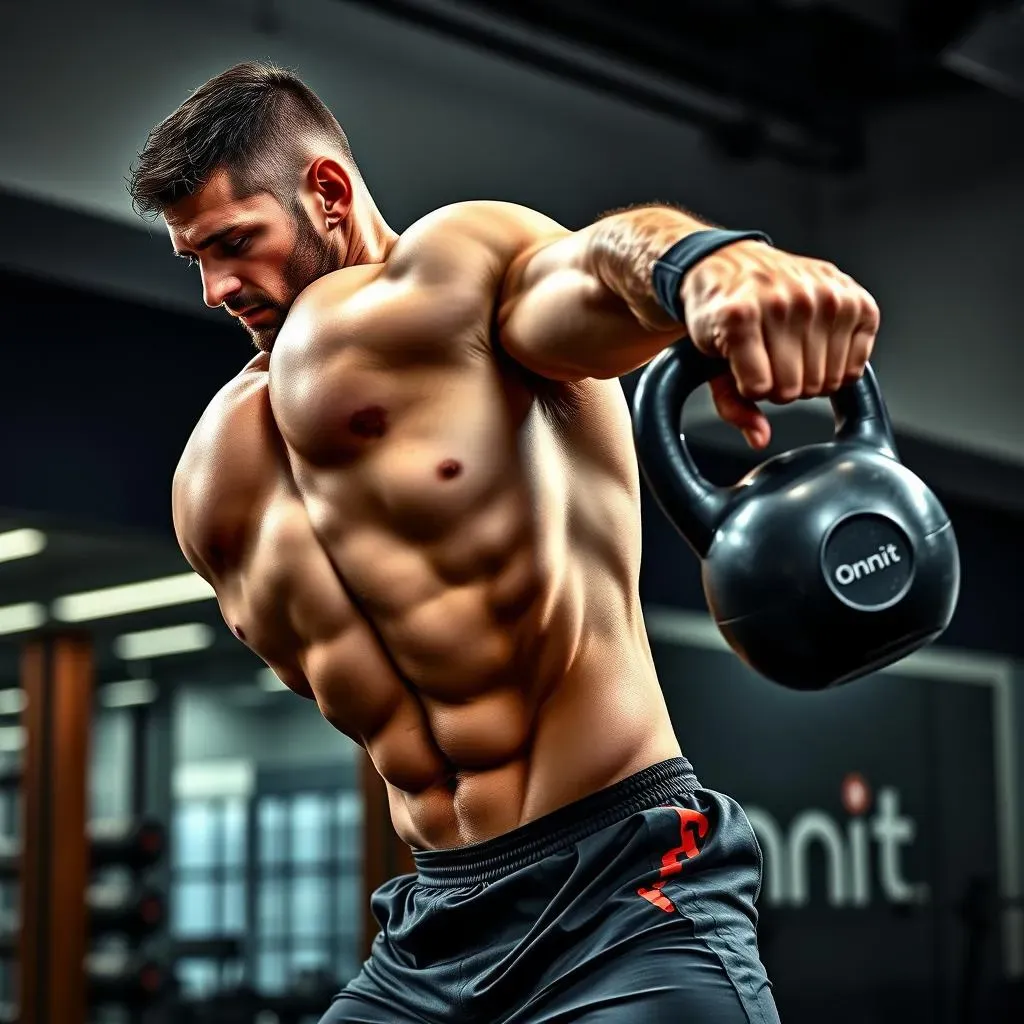Table of Contents
No squat rack? No problem. You don't need a fancy gym to build a powerful lower body. This kettlebell leg workout Onnit-style is designed to torch your quads, hamstrings, and glutes using just a kettlebell and your own bodyweight. Forget those endless hours on machines – we're talking functional strength, real-world power, and a physique that turns heads.
Why Kettlebells and Bodyweight Are Enough for Leg Day

Why Kettlebells and Bodyweight Are Enough for Leg Day
so you're thinking, "Can I *really* build impressive legs without a leg press or a mountain of plates?" Absolutely. The beauty of kettlebells and bodyweight exercises lies in their ability to provide unique challenges that traditional weightlifting often misses. Kettlebells, for instance, force you to control unstable loads, which skyrockets muscle activation, especially in your core and stabilizer muscles. Ever tried a single-leg deadlift with a kettlebell? It's a humbling experience, but it hammers your hamstrings and glutes like nothing else.
And let's not underestimate the power of bodyweight. Think beyond basic squats. Variations like pistol squats, jump squats, and Bulgarian split squats can be incredibly demanding, building strength, power, and serious muscle endurance. Plus, bodyweight training improves your balance, coordination, and overall athleticism – things you won't necessarily get from just pushing weight on a machine. It's about working smarter, not just harder.
Training Style | Benefits | Examples |
|---|---|---|
Kettlebell Training | Unstable loads, core activation, functional strength | Kettlebell Swings, Goblet Squats, Single-Leg Deadlifts |
Bodyweight Training | Improved balance, coordination, athleticism, muscle endurance | Pistol Squats, Jump Squats, Bulgarian Split Squats |
Consider this: a study published in the Journal of Strength and Conditioning Research found that kettlebell training can be just as effective as traditional weightlifting for improving strength and power. The key is to focus on proper form, progressive overload, and challenging variations. This kettlebell leg workout will work all your major muscles.
The Onnit Kettlebell Leg Workout: Exercises for Strength and Power

The Onnit Kettlebell Leg Workout: Exercises for Strength and Power
Kettlebell Swings: Power and Posterior Chain Development
The kettlebell swing is the cornerstone of this workout. It's not just a cardio exercise; when done correctly, it's a powerful movement that builds explosive hip drive, strengthens your hamstrings and glutes, and improves your overall athleticism. Think of it as a dynamic deadlift – you're hinging at the hips, not squatting, and driving the kettlebell up with a powerful glute contraction. This exercise will translate to more power in your jumps, sprints, and everyday movements.
Rear-Foot Elevated Split Squats: Unilateral Strength and Stability
Also known as Bulgarian split squats, these are brutal, but incredibly effective for building single-leg strength and stability. By elevating your rear foot, you increase the range of motion and place more emphasis on your quads, glutes, and hamstrings of the front leg. This exercise also challenges your balance and coordination, forcing your stabilizer muscles to work overtime. If you want to build balanced, functional strength, rear-foot elevated split squats are a must.
If you’re new to this exercise, start with bodyweight only. As you get stronger, add a kettlebell in a goblet position (holding it close to your chest) or in each hand for an added challenge.
Squat Jumps: Explosive Power and Vertical Leap
Squat jumps add a plyometric element to the workout, developing explosive power and improving your vertical jump. The goal here is to jump as high as possible, landing softly and immediately going into the next rep. Focus on using your legs to generate the power, not just flopping up and down. These jumps will not only build leg muscle, but also improve your athletic performance in any sport that requires jumping or sprinting. Think basketball, volleyball, or even just running to catch the bus.
Kettlebell Leg Workout Directions: Sets, Reps, and Rest

Kettlebell Leg Workout Directions: Sets, Reps, and Rest
Warm-Up: Get the Blood Flowing
Before you jump into the heavy stuff, you need to prime your muscles and joints. This kettlebell leg workout starts with a simple, but effective warm-up: jump rope for 3 minutes. This will increase your heart rate, improve blood flow to your legs, and prepare your body for the work ahead. Think of it as greasing the wheels before a long drive – you wouldn't hit the highway without checking your oil, would you?
After the jump rope, do a few dynamic stretches like leg swings, hip circles, and torso twists. The goal is to get your body moving and feeling good, not to exhaust yourself before the workout even begins. A proper warm-up can prevent injuries and improve your performance, so don't skip it!
- Jump Rope: 3 minutes
- Leg Swings (forward and sideways): 10 reps each leg
- Hip Circles: 10 reps each direction
- Torso Twists: 10 reps each direction
The Workout Structure: Sets, Reps, and Intensity
Now for the main event. This kettlebell leg workout is designed to be challenging but scalable. Adjust the weight and reps as needed to match your current fitness level. Remember, it's better to start with good form and lighter weight than to go too heavy and risk injury. The key is to push yourself, but also to listen to your body.
Here's the breakdown: Perform the exercises in the order listed, resting for 60-90 seconds between sets. For the kettlebell swings and rear-foot elevated split squats, focus on lifting heavy and maintaining good form. For the squat jumps, prioritize explosive power. And for the goblet squats and suitcase walking lunges, aim for higher reps to build muscle endurance. The final set of walking lunges is a killer – 100 total reps, alternating legs. Embrace the burn!
Exercise | Sets | Reps | Rest |
|---|---|---|---|
Kettlebell Swings | 3 | 10-12 | 60-90 seconds |
Rear-Foot Elevated Split Squats | 3 | 8-10 each leg | 60-90 seconds |
Squat Jumps | 3 | 10-15 | 60-90 seconds |
Goblet Squats | 3 | 15-20 | 60-90 seconds |
Suitcase Walking Lunges | 1 | 100 total reps (alternating legs) | As needed |
Mastering the Moves: StepbyStep Kettlebell Exercise Instructions

Mastering the Moves: StepbyStep Kettlebell Exercise Instructions
Kettlebell Swing: The Hip Hinge
let's break down the kettlebell swing. Stand with your feet shoulder-width apart, the kettlebell a few inches in front of you. Hinge at your hips, pushing your butt back like you're closing a car door with it. Keep your back straight – think proud chest – and grab the kettlebell with both hands. Hike the kettlebell back between your legs, like you're snapping a towel. Then, explosively drive your hips forward, squeezing your glutes to propel the kettlebell up to chest height. Let the kettlebell swing back down naturally, and repeat. The power comes from your hips, not your arms. Imagine you're trying to launch that kettlebell with your butt!
Rear-Foot Elevated Split Squat: Balance is Key
For the rear-foot elevated split squat (Bulgarian split squat), you'll need a bench or box about knee-height. Stand facing away from the bench, and place the top of one foot on it. Your front foot should be far enough forward that your knee doesn't go past your toes when you squat. Keeping your chest up and core engaged, lower your back knee towards the ground until your front thigh is parallel to the floor. Push through your front heel to return to the starting position. This exercise is all about balance, so start slow and focus on control. If you're wobbling all over the place, ditch the weight and practice with just your bodyweight until you feel stable.
Here are some common mistakes and how to fix them:
- Rounding your back: Keep your chest up and core engaged.
- Knee going past your toes: Adjust your front foot position.
- Wobbling: Focus on a fixed point in front of you and engage your core.
Squat Jump: Land Softly
Squat jumps are simple in theory, but require proper technique to avoid injury. Stand with your feet shoulder-width apart. Squat down until your thighs are parallel to the floor, just like a regular squat. Then, explosively jump up as high as you can, extending your hips, knees, and ankles. Focus on landing softly, absorbing the impact with your legs. Immediately go into the next rep. The key here is to use your legs to generate the power, not just flopping up and down. Think about pushing through the floor with your feet.
Progressing Your Kettlebell Leg Workout for LongTerm Gains

Progressing Your Kettlebell Leg Workout for LongTerm Gains
Alright, you've crushed the kettlebell leg workout for a few weeks. You're feeling stronger, your legs are looking more defined, and you're ready for the next level. That's awesome! But here's the thing: your body is incredibly adaptable. If you keep doing the same workout, your progress will eventually plateau. To keep those gains coming, you need to progressively overload your muscles, and there’s several ways to do it.
Think of it like this: your muscles are like whiny toddlers. They only grow when you force them to do something they don't want to do. So, how do we keep them whining? By constantly challenging them in new and creative ways. Let's dive into some strategies to keep your kettlebell leg workout fresh and effective for the long haul.
- Increase the weight: This is the most obvious way to progress. If you're comfortably doing 12 reps of kettlebell swings with a 24kg bell, try bumping it up to 28kg or 32kg. Even a small increase can make a big difference.
- Increase the reps: If you don't have access to heavier kettlebells, try increasing the number of reps you perform for each set. For example, instead of doing 10 reps of rear-foot elevated split squats, aim for 12 or 15.
- Increase the sets: Add an extra set to each exercise. This will increase the overall volume of the workout and challenge your muscles even further.
But it's not just about adding more weight, reps, or sets. You can also progress by changing the exercises themselves. Swap out goblet squats for front squats, or try pistol squats instead of regular squats. These variations will challenge your muscles in new ways and prevent boredom. Remember, the key is to keep your body guessing!
Also, play with tempo. Slow down the eccentric (lowering) phase of each exercise to increase time under tension. Or, add pauses at the bottom of the squat to challenge your strength and stability. These small tweaks can make a big difference in the effectiveness of your workout.
Progression Method | Description | Example |
|---|---|---|
Increase Weight | Use a heavier kettlebell. | Go from 24kg to 28kg kettlebell swings. |
Increase Reps | Perform more repetitions per set. | Do 15 reps instead of 10 for goblet squats. |
Increase Sets | Add an additional set to each exercise. | Perform 4 sets instead of 3 for rear-foot elevated split squats. |
Change Exercises | Substitute variations of existing exercises. | Replace goblet squats with front squats. |
Manipulate Tempo | Adjust the speed of the exercise. | Slow down the eccentric phase of the squat. |
Finally, don't forget about rest and recovery. Your muscles need time to rebuild and repair after a tough workout. Make sure you're getting enough sleep, eating a healthy diet, and managing your stress levels. Overtraining can lead to injuries and plateaus, so listen to your body and take rest days when you need them.
So, there you have it. A few simple strategies to keep progressing your kettlebell leg workout and building those tree trunk legs. Remember, consistency is key. Stick with it, challenge yourself, and enjoy the process. You got this!
Conclusion: Your Kettlebell Leg Journey Starts Now
So, there you have it – a complete kettlebell leg workout Onnit-approved, ready to be unleashed. This isn't just about building bigger legs; it's about building a stronger, more functional you. Remember to focus on proper form, progressively increase the challenge, and listen to your body. Now go grab that kettlebell and get to work. Your tree trunk legs await!